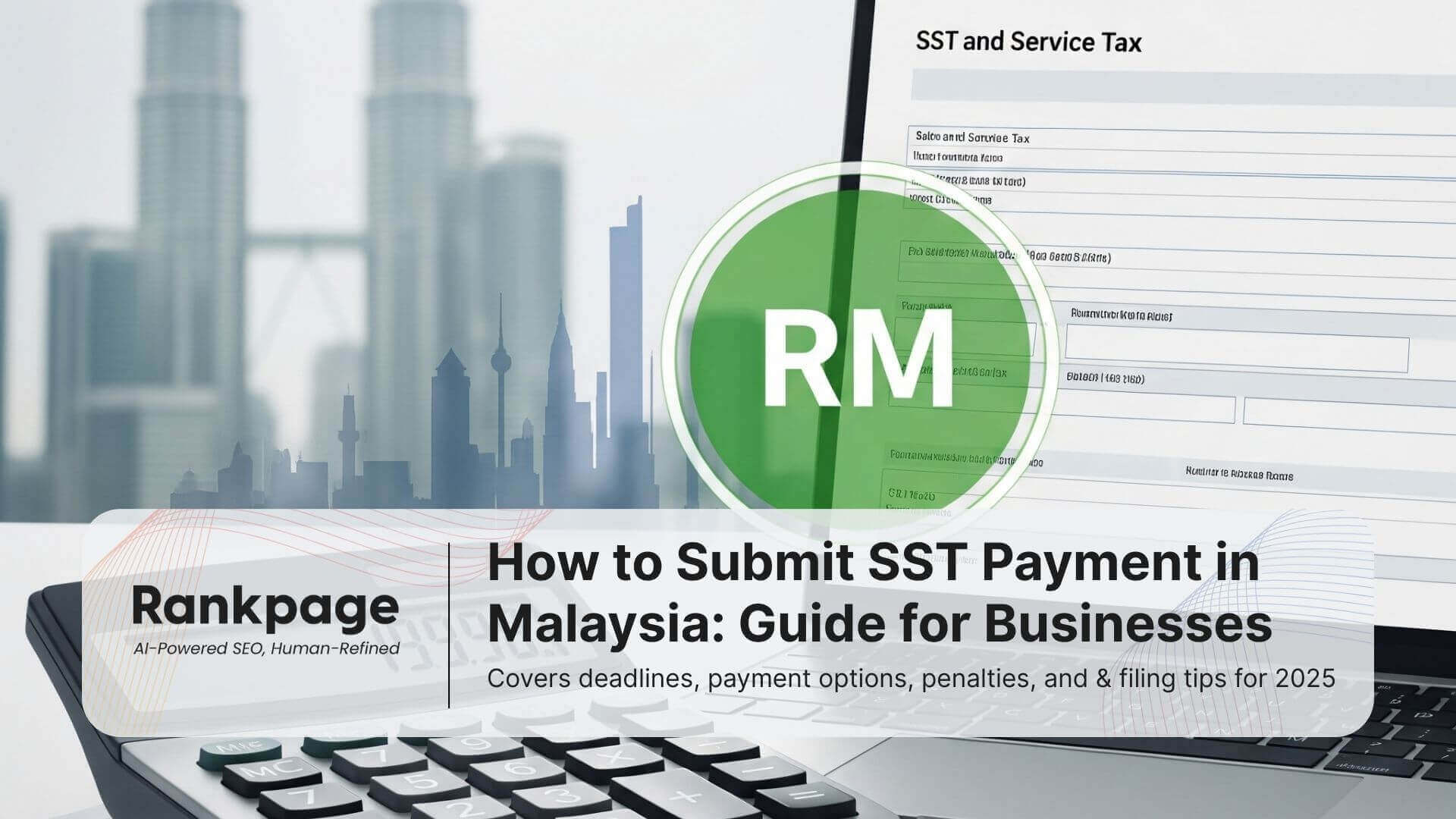Key Takeaways
- SST is submitted every two months using the SST-02 form via the MySST portal.
- Payment deadline is the last day of the following month after your taxable period ends (March-April returns are due 31 May).
- Pay SST via FPX on MySST, or by cheque/bank draft to the Customs Processing Centre (CPC). Cash and cards aren’t accepted.
- Late filing or payment triggers penalties of 10% to 40%, plus surcharge.
- Businesses exceeding SST thresholds (RM500k for most services) must register via MySST within 30 days.
To submit SST in Malaysia, log into MySST, generate your SST-02 return, confirm taxable sales/services, and make payment via FPX. Submissions are due every 2 months, by the last day of the following month.
Miss your SST deadline and you’re not just kena fine, you risk being flagged by Customs for audit. And no, “I didn’t know mah” won’t work. Whether you sell bubble tea or run a logistics firm, SST compliance isn’t optional and the government is serious about enforcement.
To save businesses big and small from a RMCD visit, we will walk you through the necessary SST submission step-by-step, filing timelines, return forms, payment tips, and what to do if you missed the deadline.
Table of Contents
What Is SST Payment and Who Needs to Submit It?
SST is an indirect tax imposed on certain goods and services under the Sales Tax Act 2018 and Service Tax Act 2018. Businesses must collect SST from customers and remit it to the Royal Malaysian Customs Department (RMCD).
You’re legally required to file SST returns if your business falls under either of these categories:
Business Category | SST Type | Examples |
Manufacturers of taxable goods | Sales Tax | Food factories, packaging producers, plastic product manufacturers |
Providers of taxable services | Service Tax | Restaurants, hotels, logistics firms, telecom providers, cleaning services |
Thresholds:
- Sales Tax: Applies only to registered manufacturers, not retailers.
- Service Tax: Required if annual taxable turnover exceeds RM500,000, though some sectors (hotels, F&B) have lower thresholds.
Quick Reference Table
Sector | Threshold | Notes |
Most taxable services | RM500,000 | Standard |
F&B (restaurants, caterers) | RM1,500,000 | Higher threshold |
Hotels & accommodation | RM500,000 | Must register once exceeded |
Credit/charge card providers | No threshold | Tax applies regardless |
Parking operators | No threshold | Immediate liability |
Gaming, clubs, betting | No threshold | Immediate liability |
Source: Royal Malaysian Customs Department – SST Guidelines
Even Zero-Rated? Still Must File.
Even if your tax due for the period is RM0, you still need to submit the SST-02 form. Failure to do so can result in penalties.
You must register for SST via MySST within 30 days of reaching the taxable threshold.
For example, for the period July–August, you must submit and pay by the end of September.
When Is Payment Not Required?
Even if you file an SST-02 return, payment is not required if:
- You had no taxable sales or services
- All your supplies were exempt or zero-rated
- Your SST-02 shows RM0 payable
Still, filing is compulsory even when no payment is due, to stay compliant and avoid penalties.
When Is the SST Payment Deadline in Malaysia?
SST returns are filed bi-monthly and are due on the last day of the following month.
Here’s how the cycle works:
Taxable Period | SST Due Date |
Jan – Feb | 31 March |
Mar – Apr | 31 May |
May – Jun | 31 July |
Jul – Aug | 30 September |
Sep – Oct | 30 November |
Nov – Dec | 31 January (next year) |
The deadline applies to both form submission and payment.
Returns and payment are due by the last day of the month following the taxable period. Late filings/payments incur the statutory penalties.
Where Do You Submit SST Online?
All SST returns and payments are submitted through the MySST portal.
You’ll need a registered account, then select the correct Sales Tax (CJ) or Service Tax (CP) account before filing SST-02.
To access it, you’ll need:
- A registered MySST account (linked to your business SSM number)
- Login credentials: User ID and password
- Access to your CJ(P) profile:
- CJ(P)1 = Sales Tax
- CJ(P)2 = Service Tax
Once inside, you’ll be able to:
- File your SST-02 form
- Check past submissions under “My Filing History”
- Make or view payments
- Download official receipts and PDF returns
Source: Royal Malaysian Customs Department (RMCD) – MySST Portal
How Do You Submit the SST-02 Form?
The SST-02 form is filed every two months, and it only takes 10–15 minutes if your accounts are in order, so no excuses, Kastam would not buy it.
Step-by-Step Submission Guide:
- Log in to MySST
- Go to Submission → Select “SST-02”
- Choose your CJ(P) profile (Sales or Service Tax)
- Fill in the form:
- Declare taxable sales/services. The system calculates the tax at the prescribed rate
- Sales Tax commonly 5% or 10% per tariff
- Service Tax generally 8% since 1 Mar 2024 with specified services still 6%
- Attach supporting documents (optional but encouraged):
- Monthly sales reports
- Internal tax breakdown (Excel or PDF)
- Submit the form
- You’ll receive a reference number
- The SST-02 return will be archived under “My Filing History”
Even if no tax is due (zero-rated), you must still submit a “NIL return” for that period.
How Do You Make SST Payment After Filing SST-02?
Once SST-02 is submitted, pay before the deadline via:
1) FPX on MySST → select your bank and authorise payment.
2) Cheque/bank draft to the Customs Processing Centre (CPC).
If your FPX amount exceeds the limit, pay by cheque at the Customs payment counter. Cash and cards are not accepted.
What Happens After Payment?
- A payment receipt (PDF) will be auto-generated in your MySST account
- You can find it under “Payment History”
- Keep this for audit and record-keeping purposes (minimum 7 years)
Source: MySST Official Portal – FAQ & User Guide
What Happens If You Miss the SST Payment Deadline?
Didn’t set that reminder on your phone? Missed your tax deadline while busy juggling sales, stock checks and end of the month sales?
Don’t panic, yet. RMCD enforces tiered late payment penalties under Section 89 of the SST Acts.
SST Late Payment Penalty Structure
Days Late | Penalty (Cumulative %) | What It Means |
1–30 days | 10% of tax payable | Automatically added once you’re even 1 day late |
31–60 days | 5% (total 15%) | Additional 5% added on top of the 10% |
61–90 days | Additional 15% (cumulative 40% max) | Final surcharge, after this, things escalate |
Other Consequences of Missing SST Deadlines
- Compoundable Offences
RMCD may issue compound fines on top of penalties under Section 90. - Audits or Investigations
Late or irregular submissions can trigger a compliance audit, even for small businesses. - Business Licensing Risk
Ongoing non-compliance may lead to issues with:- Customs import/export licenses
- Company blacklisting
- Future SST registration approval
- Blocked Claims & Refunds
Late payers may face delays in SST refunds or denied offset claims.
What Can You Still Do If You’re Late?
- Pay Immediately
Even if you’re late, paying ASAP reduces compounding penalties. - Check Penalty Breakdown
MySST portal shows your current penalty amount and timeline. - Contact RMCD If Justified
If there’s a valid reason (system outage, bank rejection), contact Customs with proof and request reconsideration. - Keep Good Records
Save your submission timestamps, payment receipts, and correspondence for 7 years in case of future audits.
What Are Common SST Filing Mistakes to Avoid?
Even seasoned finance teams can slip up when filing SST. These errors might seem small, but they can trigger penalties, audits, or even tax shortfall notices. Here’s what to watch for:
Submitting Under the Wrong CJ(P) Profile
Sales Tax vs Service Tax? This is a very common mistake most first-time SST filers get wrong.
- Businesses registered for both may accidentally submit under the wrong profile.
- For example, submitting your SST-02 under “Sales Tax” when you meant “Service Tax” (or vice versa) causes filing rejections and payment misallocations.
Always double-check your CJ(P) profile at login.
Using Incorrect Tax Codes or Rates
- Entering the wrong tax code (SR instead of ZR) or applying incorrect rates (10% instead of 5%) can lead to overpayment or underpayment.
- This affects your credit offsets and raises audit flags.
Always refer to RMCD’s latest SST Code Listing before each submission.
Missing Zero-Rated or Exempt Declarations
- Many forget to declare zero-rated, exempt, or non-taxable items, even though they must still be reported in SST-02.
- Omission skews your records and may affect input-output reconciliation during audits.
Include all zero-rated sales or services in your SST-02 summary.
Forgetting to Pay After Filing
It sounds silly but yet, this does happen.
- Filing SST-02 does not mean you’ve paid.
- Many users assume clicking “submit” completes everything, until a 10% penalty shows up.
Always complete the FPX payment step or bank-in process after form submission. Don’t wait until the next day.
Backdating or Missing Data
- Submitting SST-02 with incomplete data, or trying to backdate sales/service records, is non-compliant.
- RMCD may reject your filing, and persistent errors could lead to compound fines.
Always reconcile sales and service records before month-end, not during last-minute filing.
Conclusion: Submitting SST Doesn’t Have to Be Complicated
SST filing can feel tedious, and let’s be real, it is. But with a checklist, timely reminders, and the right process, staying compliant is manageable.
The same goes for your digital presence. Just like tax compliance builds trust with RMCD, SEO builds trust with customers and Google. At Rankpage, we help businesses strengthen online visibility, reduce lost traffic (like abandoned payments), and boost conversions.
Ready to grow your business with the best seo company? Talk to us today!
Frequently Asked Questions About SST Payment in Malaysia
How do I pay SST online in Malaysia?
Log in to MySST and pay via FPX immediately after submitting SST-02.
Do I need to Register to submit SST?
Yes, you must be registered with Royal Malaysian Customs and have a MySST login.
Can I use Credit Card for SST payment?
Credit/debit cards and cash are not accepted. Pay via FPX or cheque/bank draft to CPC (or cheque at Customs counter if FPX exceeds limit).
Is SST and GST the same in Malaysia?
No. GST was abolished in 2018. SST is a single-stage tax (sales or services only).
What is the SST-02 form?
It’s the standard return form used to declare and pay SST every 2 months via MySST.
What happens if I submit SST late?
You’ll incur up to 40% penalty plus potential surcharge or legal action by Customs.





